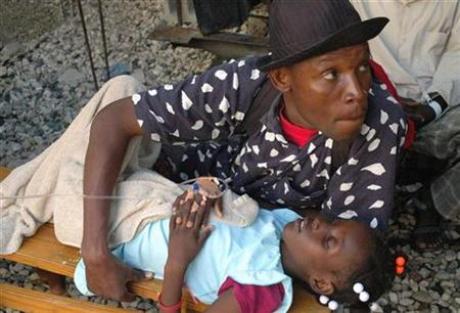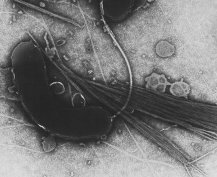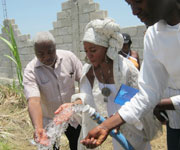(Note: HLLN was at forefront of exposing the UN’s gross negligence and cover-up for bringing the cholera plague to Haiti in October 2010; wrote Haiti’s case against the UN for importing cholera before the month of Oct. 2010 was over, writing also the UN Responsibility for importing cholera et al…)
****************************
Did Harvard scientists help the UN cover-up the source of Haiti’s cholera for 11-months?
By Dady Chery, Original Source: Axis of Logic
 A Haitian resident holds his relative who is suffering from cholera at St-Catherine hospital in the slum of Cite-Soleil in Port-au-Prince November 12, 2010. Photo: St-Felix Evens, Reuters
A Haitian resident holds his relative who is suffering from cholera at St-Catherine hospital in the slum of Cite-Soleil in Port-au-Prince November 12, 2010. Photo: St-Felix Evens, Reuters
It took nearly a year since the start of Haiti’s cholera epidemic for scientists to get conclusive proof that the cholera bacteria in Haiti are identical to bacteria in Nepal. Drs. Frank Aarestrup from Denmark, Paul Keim from Arizona, and Geeta Shakya from Kathmandu led a recent study that provided this evidence.
The DNA in cholera changes rapidly when these bacteria infect humans. This makes the cholera a moving target and very difficult to vaccinate against. On the other hand, when two cholera turn out to be identical, one can say with confidence that they originated from the same place/infected person(s).
 dna double helix sequence
dna double helix sequence
By comparing the complete DNA sequences (also called “genomes”) from the cholera in Haiti to the complete DNA sequences from cholera in Nepal, the international group of scientists found that Haiti’s cholera exactly matches one of four Nepalese cholera. The resemblance between the Haitian and Nepalese cholera was so strong that, in a sequence of about 4,000,000 DNA bases, all agreed except for one or two. This is as good as comparing one Complete Volume of Shakespeare’s works to a new tome from a different publisher, discovering that there are no more than one or two single-letter differences between them, and concluding that both are indeed the complete Shakespeare. The techniques for this type of study are enormously expensive but very quick and not especially demanding.
 The Vibrio Cholerae O1 Ogawa Biotype El Tor bacteria identified as the single source of cholera in Haiti. (source) One could reasonably ask if it is necessary to compare every letter in two volumes of Shakespeare to decide that they are the same. Why not scan, for example, through the section headings for the same sequences of acts in the plays and the same succession of sonnets? Indeed there exist older and cheaper techniques for examining DNA that do something of the sort. This is how the Center for Disease Control (CDC) found that the cholera strain in Haiti is Vibrio Cholerae O1 Ogawa Biotype El Tor. It is also how the CDC discovered that every Haitian who got cholera had the identical bacteria, which was taken to mean that the Haitian epidemic had a single source.
The Vibrio Cholerae O1 Ogawa Biotype El Tor bacteria identified as the single source of cholera in Haiti. (source) One could reasonably ask if it is necessary to compare every letter in two volumes of Shakespeare to decide that they are the same. Why not scan, for example, through the section headings for the same sequences of acts in the plays and the same succession of sonnets? Indeed there exist older and cheaper techniques for examining DNA that do something of the sort. This is how the Center for Disease Control (CDC) found that the cholera strain in Haiti is Vibrio Cholerae O1 Ogawa Biotype El Tor. It is also how the CDC discovered that every Haitian who got cholera had the identical bacteria, which was taken to mean that the Haitian epidemic had a single source.
“The only reason it took so long to discover that Haiti’s cholera came from Nepal is because scientists had until now not bothered to compare the cholera from Haiti to cholera from Nepal.” If expense was an issue for the CDC, it certainly was not for the groups that favor the current technology. According to the latter, two cholera-sized “books” can be scanned at “single-letter” resolution over 30 times in less than 24 hours.
So why did it take 11 months to nail the source of Haiti’s cholera? The only reason it took so long to discover that Haiti’s cholera came from Nepal is because scientists had until now not bothered to compare the cholera from Haiti to cholera from Nepal.
Back when a precise knowledge of the source of the epidemic would have saved lives and probably aborted the renewal of the U.N. (MINUSTAH) mandate in Haiti, John Mekalanos’ group at Harvard promised to carry out the study that was finally done by Aarestrup, Keim, and Shakya. Mekalanos argued that the conclusive proof of the origin of any cholera could only come from studies using the most modern methods. Other scientists deferred to Harvard, first because, well, it was Harvard, and second, because they could not afford the new technology. Instead of doing a proper study, however, Mekalanos’ group compared the DNA of the cholera from Haiti to the DNA of three types of cholera from different epidemics. Not a single one was from Nepal.
In the end the Harvard group published an article in which the word “Nepal” did not appear even once. The cholera they used were from an epidemic in Peru and two different epidemics in Bangladesh. They merely concluded that the cholera in Haiti is Asian: a fact that was already known from the CDC studies.
Dr. Mekalanos had this to say during an interview with Science Watch in February 2011:
“My colleagues and I have been very clear in saying that the genomic evidence says that this strain in Haiti has its origin in South Asia. True, Nepal is part of South Asia so it clearly needs more investigation and a commission has been established by the UN to look into the possibility.”
Without exaggerating, one might say, for example, that the cholera study by Harvard was analogous to using the most sensitive instruments and best-trained scientists to test for Fukushima radiation everywhere in the globe except Japan, reporting that the meltdowns had probably happened somewhere in Asia, and then proposing that a commission from the nuclear-power companies finish the investigation.
Unlike the Harvard group, the Denmark and Arizona scientists collaborated with Katmandhu researchers who gave them access to cholera samples collected from 24 patients in five Nepalese districts between July 30th and November 1st 2010. Given that the Nepalese government has violently protested all mentions of any association with the epidemic, the Nepalese scientists who participated in this project did so at considerable personal risk. It made sense to look in Nepal for a possible source for Haiti’s cholera, because U.N. troops arrived fresh from the cholera epidemics in Nepal days before the first Haitian case of the disease was diagnosed.
The fact that the Harvard group discovered nothing much about Haiti’s cholera did not prevent them from admonishing Haitians to be immediately vaccinated. They did so although cholera vaccines are not recommended by the Word Health Organization (WHO) even to tourists entering areas with endemic cholera. Such vaccines are considered worse than useless because they give the illusion of protection and encourage reckless behavior. Since the cholera change rapidly, vaccination lasts for only about six months even against the cholera strains for which the vaccines are made. Moreover, the vaccines give zero protection against other cholera strains.
But here is what Mekalanos” colleague Dr. Matthew Waldor said:
“It’s time to seriously consider vaccinating people who live in Haiti and the Dominican Republic, not only to save lives there, but to prevent the spread of this new strain to other countries in the region.”
Science, Universities, Corporations and Profits
I was so impressed by this enthusiasm for vaccines that I decided to look into the list of disclosures that the Harvard scientists had to fill for their publication. I discovered the following:
Several of the Harvard Scientists own stock in Pacific Biosciences, a company that makes the machines and all the supplies for the expensive new method of DNA sequencing that they had been promoting. One person on the project was employed by Pacific Biosciences. One could say, in a way, that the Haiti cholera study was an advertisement for PB’s products.
 Harvard’s Haiti cholera study can be seen as an advert for Pacific Biosciences where some of them owned stock. The photo shows off Pacific Sciences $700 million dna sequencing machine. Their 2011 2nd quarter revenues totaled $10.6 million and gross profit, $7.9 million.
Harvard’s Haiti cholera study can be seen as an advert for Pacific Biosciences where some of them owned stock. The photo shows off Pacific Sciences $700 million dna sequencing machine. Their 2011 2nd quarter revenues totaled $10.6 million and gross profit, $7.9 million.
Dr. John Mekalanos and his corporate interests
Dr. Mekalanos is involved in cholera-vaccine development. He and Harvard University receive royalties from Vaccines Technologies Inc., a company that entered an exclusive license and development agreement with Celldex Therpeutics Inc. (formerly AVANT Immunotherapeutics, Inc.) in January 2009. The agreement allows VTI to develop and commercialize Celldex’s CholeraGarde(R) vaccine program.
He is co-founder of three biotechnology firms, Virus Research Institute, PharmAthene and most recently, Matrivax). Virus Research Institute later merged with another company and became Avant Immunotherapeutics, a firm that receives grants from the NIH.
Mekalanos’ PharmAthene is a biodefense company involved with the development and commercialization of medical countermeasures against biological and chemical weapons. Their customers included the U.S. Defense Department, National Institute of Allergy and Infectious Diseases, Biomedical Advanced Research and Development Authority, and the U.S. National Institutes of Health. For the 2nd quarter of 2011 PharmAthene saw revenues of $6.4 million compared to $4.8 million the same period of 2010 an increase of $1.6 million. His company’s SparVax program, totaled $5.3 million for the three months ending June 30, 2011 compared to $2.1 million for the same period in 2010.
Mekalanos’ third company, Matrivax Research & Development Corporation in Boston is a small private corporation with only 8 employees that received an annual revenue of $710,000 last year, shared by Mekalanos, his 2 partners and employees. He is Director of Matrivax which is privately funded including grants from the Bill Gates foundation.
Mekalanos is also the founder of Virus Research and Versicor. Versicor is at least a multi-million dollar corporation, gaining $22 million in investments in 1997 alone. That same year, they targeted, “the substantial worldwide medical need for antibiotics [that] is evidenced by the current market size, which currently exceeds $23 billion dollars.” The company “gained access to proprietary technology for the identification of novel drug targets in bacteria from the laboratory of Professor John Mekalanos, Chairman of the Department of Microbiology and Molecular Geneticsmolecular genetics.”
According to his Executive Profile in Bloomsberg/Businessweek, information on Mekalanos’ annual income, stock options and total compensation is not available.
Mekalanos has not let any conflict of interest stop him from flogging his vaccine:
“When I heard in January 2010 that an earthquake had hit Haiti, the first thing that crossed my mind was ”how long?” I knew cholera would happen, sooner or later, the only question was when.
“Why wasn’t it stockpiled? You’ll never stockpile this vaccine without a few global health organizations saying it makes sense to do so. And the obvious organization, the one which stands right in the cross hairs, is the WHO. It takes courage to make that statement and stand by it.
“By way of full disclosure, I have been involved in developing cholera vaccines so you might say I’m conflicted. However, others have made cholera vaccines too. The problem has not been as much making a safe and effective vaccine. It is getting agencies to say they are willing to use it as part of public policy. After that I’m sure we can figure out how to get that global stockpile made.”
The idea that earthquakes cause cholera is patently absurd. In Haiti, the cholera appeared explosively in the Artibonite region: a rural area that had suffered no damage from the earthquake. By contrast, in Port-au-Prince, where the earthquake damage was massive, the incidence of cholera was five times lower than in the Artibonite.
Interestingly, the most enthusiastic support for Harvard’s efforts to vaccinate Haitians has come from none other than U.N. Pan American Health Organization’s (PAHO) director Dr. John Andrus.
“I see a real opportunity to vaccinate vulnerable groups in countries that have yet to see the outbreak but we know would be very vulnerable if cholera was imported”¦. I worry about some of the poorer countries of the Caribbean. I worry about Central America.”
Andrus” first action during the epidemic was to give a press conference. There he announced that one should expect many thousands of Haitians to die of cholera, and he pleaded for donations of $164 million to the U.N. and a group of 42 NGOs that he had quickly gathered under PAHO’s umbrella.
Several times former president Preval’s government came under strong pressure from the U.N. to vaccinate the Haitian population, and every time the Haitian Ministry of Public Health refused. If the Ministry had acquiesced to the vaccination campaigns the U.N., via PAHO, would have purchased massive doses of the Mekalanos vaccine. Harvard and corporate affiliates would have made tidy profits.
It is worthwhile to note that the source of Haiti’s cholera was identified, not by U.S. or European researchers many months after the epidemic but by Haitians at home and in the diaspora within days of the first cases of cholera. In an article in Axis of Logic, I argued that the epidemic had been introduced into Haiti by the U.N. Soon thereafter Mirebalais’ Mayor and other citizens brought to the press’ attention their observation that the epidemic had started downstream of the U.N. base of Nepalese soldiers in the nearby village of Meille in the Artibonite region.
A more formal epidemiological study published this summer by Dr. Renaud Piarroux confirmed and strengthened the initial observations by Haitians.
Importantly, Piarroux’s group in France concluded that there must have been active cases of cholera among the Nepalese MINUSTAH troops last October for the dose of cholera in the Artibonite river water to have been lethal:
“To our knowledge, only infectious doses over 10,000 bacteria were shown to produce mild patent infection in healthy volunteers, and higher doses are required to provoke severe infections. Reaching such doses in the Meille River is hardly compatible with the amount of bacteria excreted by asymptomatic carriers, whereas if 1 or several arriving soldiers were incubating the disease, they would have subsequently excreted diarrheal stools containing 10 billion to 10 trillion bacteria per liter. We therefore believe that symptomatic cases occurred inside the MINUSTAH camp.”
This implies a cover up by the U.N., which continues to claim that none of its troops was ever ill with cholera.
At least six scientific studies have resulted from the Haitian cholera epidemic, though only two have yielded results of any consequence. Every one of these studies has dismissed the discoveries by Haitians as mere “rumor”, although it was these findings, together with Haitian and Cuban record keeping, that made possible the epidemiological study by the French. If Haitians had not identified the source of the cholera, it might never have been discovered; instead, the epidemic would have been blamed on the supposed bad hygiene of the poor, and the U.N. and NGOs would have exploited the epidemic as yet another occasion to enrich themselves from the misfortune of Haitians. (Note: HLLN exposed the UN’s gross negligence and cover-up at Mirebalais, writing Haiti’s case against the UN for importing cholera even before the month of Oct. 2010 was over; writing also the UN Responsibility for importing cholera, et al…)
Surprisingly the French study provided no explanation for the fact that the cholera managed to reach the off-shore island of La Gonâve, and it accepted as fact the government explanation that the prisoners who died of cholera had been given river water to drink. Actually the cholera initially spread much too rapidly throughout the country to be explained by anything but a widespread distribution of the bacteria in infected bottled water. After I pointed this out early in the epidemic, the Haitian government discontinued the “dlo nan sachèt” (water in plastic bags) that were being distributed as “purified water” throughout the country. Discontinuing this distribution of infected water probably saved lives.
Piarroux stopped short of suggesting that some means of distribution of highly infected water was involved in the epidemic. He did say, however, that he could not explain the mechanism by which people were lethally infected well downstream of the Meille tributary of the Artibonite, when the river water, moving at more than 100 cubic meters per second, should have rapidly diluted the cholera to non-lethal doses.
Certainly one of the most important lessons from the earthquake and cholera epidemic is that Haitians can be each other’s salvation. During the first days of the epidemic, when scientific investigations of its origin mattered most, there were no plans for a thorough epidemiological study nor a comparison of the DNA of the cholera in Haiti to those from Nepal. It took the international scientific community nearly a year to do its job, and at every step it had to be shamed into it by Haitians determined to help each other.
The proof that the U.N. brought the cholera epidemic into Haiti has come much too late, but perhaps some use can be derived from it apart from publications and accolades for western researchers. When the UN Security Council next considers MINUSTAH’s mandate in mid-October of this year, Drs. Renaud Piarroux, Frank Aarestrup, and Paul Keim should stand up and explain why MINUSTAH troops must be immediately removed from Haiti so as to prevent new epidemics. The scientists should additionally propose that MINUSTAH countries make reparations for polluting Haiti’s rivers and aquifers.
Instead of promoting useless vaccines to Haitians, the U.N. should compensate the families of cholera victims and finance the construction of sewage- and water-treatment plants throughout the country using Haitian labor for this enterprise at every level.
Add a comment:
Powered by Facebook Comments








